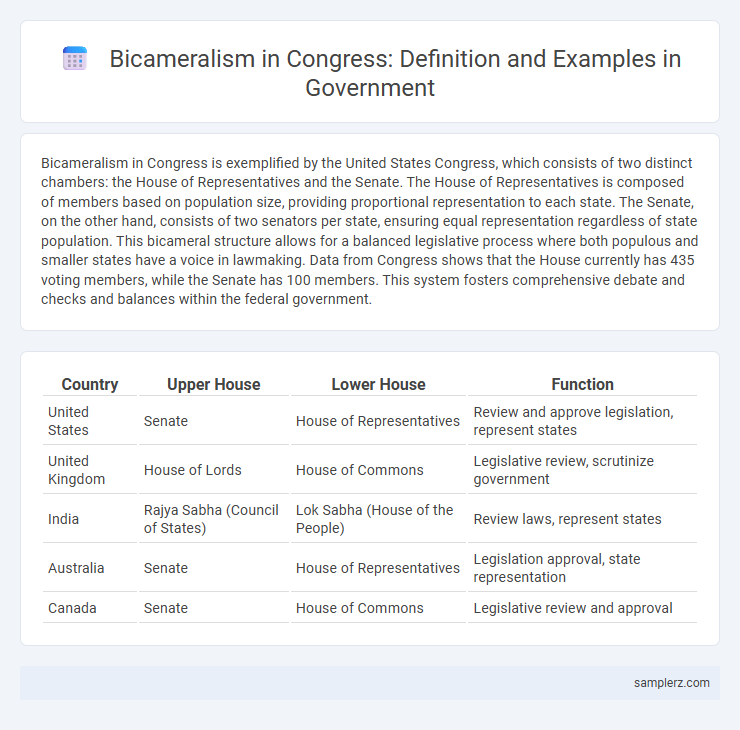Bicameralism in Congress is exemplified by the United States Congress, which consists of two distinct chambers: the House of Representatives and the Senate. The House of Representatives is composed of members based on population size, providing proportional representation to each state. The Senate, on the other hand, consists of two senators per state, ensuring equal representation regardless of state population. This bicameral structure allows for a balanced legislative process where both populous and smaller states have a voice in lawmaking. Data from Congress shows that the House currently has 435 voting members, while the Senate has 100 members. This system fosters comprehensive debate and checks and balances within the federal government.
Table of Comparison
| Country | Upper House | Lower House | Function |
|---|---|---|---|
| United States | Senate | House of Representatives | Review and approve legislation, represent states |
| United Kingdom | House of Lords | House of Commons | Legislative review, scrutinize government |
| India | Rajya Sabha (Council of States) | Lok Sabha (House of the People) | Review laws, represent states |
| Australia | Senate | House of Representatives | Legislation approval, state representation |
| Canada | Senate | House of Commons | Legislative review and approval |
Understanding Bicameralism: A Governmental Framework
Bicameralism in Congress exemplifies a governmental structure dividing legislative authority between two chambers, typically the Senate and the House of Representatives. This framework ensures balanced representation, with the Senate often representing states equally and the House based on population. Such division enhances checks and balances within the legislative process, promoting comprehensive debate and preventing the concentration of power.
Origins of Bicameralism in the U.S. Congress
Bicameralism in the U.S. Congress originates from the Constitutional Convention of 1787, where delegates sought to balance representation between populous and smaller states. The resulting Great Compromise established a two-chamber legislature consisting of the House of Representatives, based on population size, and the Senate, with equal representation from each state. This structure reflects the federal principle and aims to prevent the concentration of power, ensuring both democratic fairness and state sovereignty.
The Structure of Congress: House vs. Senate
The United States Congress exemplifies bicameralism through its two distinct chambers: the House of Representatives and the Senate. The House consists of 435 members apportioned based on state population, emphasizing proportional representation, while the Senate includes 100 members, two from each state, ensuring equal representation. This structure balances population-based interests in the House with state sovereignty in the Senate, shaping legislative processes and federal governance.
Key Functions of a Bicameral Legislature
The United States Congress exemplifies bicameralism, consisting of the Senate and the House of Representatives, each holding distinct responsibilities. The Senate confirms presidential appointments and ratifies treaties, serving as a check on executive power, while the House initiates revenue bills and represents population-based interests. This division ensures a balanced legislative process, preventing hasty lawmaking and promoting thorough debate and diverse representation.
Historical Examples of Bicameralism Worldwide
Historical examples of bicameralism in Congress include the United States Congress, established in 1789 with its Senate and House of Representatives as a model for balancing federal and popular interests. The British Parliament, consisting of the House of Commons and the House of Lords, dates back to the 13th century and serves as a foundational example of bicameral legislative structure. Other significant instances include the French Parliament under the Third Republic, featuring the Senate and Chamber of Deputies, which exemplified bicameralism's role in stabilizing governance.
Advantages and Disadvantages of Bicameral Systems
Bicameralism in Congress, exemplified by the United States with its House of Representatives and Senate, provides advantages such as balanced representation by population and state, fostering thorough debate and preventing hasty legislation. Disadvantages include potential legislative gridlock due to conflicting agendas between chambers, and increased complexity in the lawmaking process that can slow down decision-making. This dual-chamber structure enhances checks and balances but may also reduce governmental efficiency.
Bicameralism in Action: The Lawmaking Process
Bicameralism in Congress is exemplified through the distinct functions of the House of Representatives and the Senate in the lawmaking process. Each chamber reviews, amends, and votes on proposed legislation, requiring approval from both before a bill can become law. This dual-chamber system ensures thorough debate, checks and balances, and bipartisan cooperation in federal law enactment.
Case Study: U.S. Congress as a Model of Bicameralism
The U.S. Congress exemplifies bicameralism through its two chambers: the House of Representatives and the Senate, each with distinct powers and responsibilities. The House, based on population, focuses on budget and revenue bills, while the Senate provides equal state representation, emphasizing foreign policy and treaties. This structure balances popular sovereignty with federalism, ensuring diverse interests are represented in legislative decision-making.
Comparing Bicameral and Unicameral Legislatures
Bicameralism in Congress, exemplified by the United States Congress with its Senate and House of Representatives, provides distinct advantages over unicameral legislatures by enabling more comprehensive debate and checks and balances within the lawmaking process. The Senate represents states equally, while the House reflects population proportionality, fostering diverse regional and demographic interests. Compared to unicameral systems, bicameral legislatures tend to produce more deliberate legislation and reduce the risk of hasty or majoritarian decisions.
The Impact of Bicameralism on American Democracy
Bicameralism in the United States Congress, consisting of the House of Representatives and the Senate, ensures a balance of power by providing two distinct chambers with different methods of representation and responsibilities. This structure promotes thorough deliberation and prevents hasty legislation, reinforcing the system of checks and balances essential for American democracy. The impact of bicameralism is evident in shaping policy outcomes, enhancing accountability, and safeguarding minority interests within the legislative process.

example of bicameralism in Congress Infographic
 samplerz.com
samplerz.com